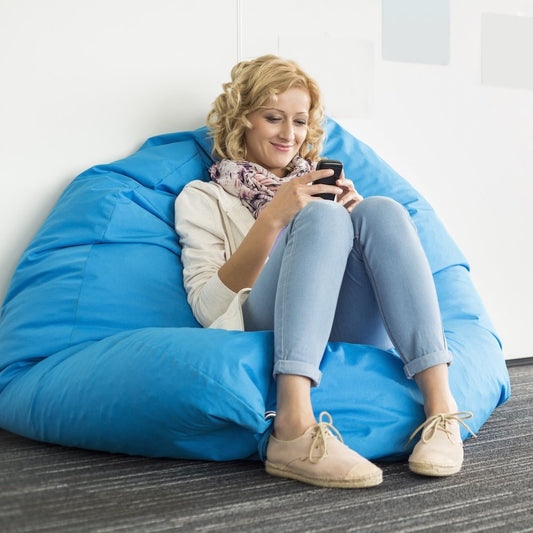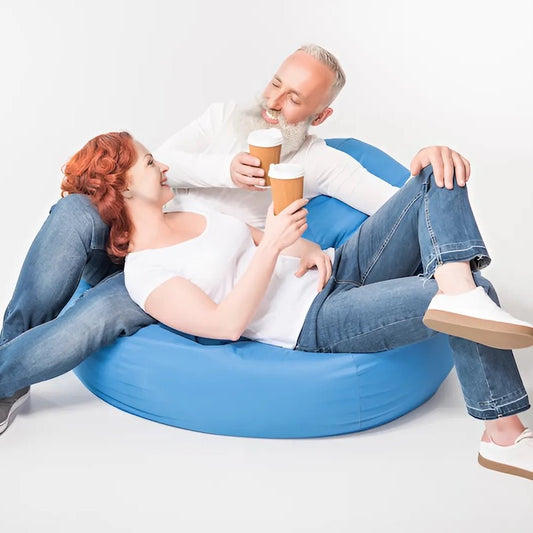The whole joy of outdoor furniture is to be able to sit down and relax while enjoying the warm sun. Can there be anything more enjoyable than going out with a cup of coffee and a good book, making yourself comfortable on the outdoor furniture cushions and diving into your favourite story? Pure bliss. Unless, of course, you discover that your beloved outdoor lounge serves as a local playground and urinating spots for the neighbourhood cats. Whether you're a cat lover or not, it is a frustrating situation. But don't panic. There are a few things you can do to keep cats off your outdoor furniture cushions.
Natural repellent using kitchen essentials
Cats are sensitive to smells. That's, in fact, the main reason why you'll find them urinating in your garden and by your outdoor furniture cushions. Cats use their scents to hide the odour of other cats and therefore mark their territories. But, you can help to curb those bad habits by injecting scents that cats find unpleasant. Find out why cats pee on bean bag chairs.
We get it, a lot of homeowners feel strongly about using chemical products in their garden, especially if they have pets of their own. However, you can make a safe cat repellent that is harmless to animals and wildlife, but that will keep cats off your outdoor furniture cushions. Cats dislike the smell of vinegar, making it the perfect ingredient for your homemade repellent. You can use a small spray bottle to mix one part of white vinegar, one part of water and one part of liquid hand soap. The mixture is safe to spray on your outdoor furniture, including cushions. Be careful not to spray too much liquid, though, as it could create a moist terrain favourable for mould growth inside the cushion. Alternatively, if you're worried about stains, you can also spray it at the base of your furniture and at random in the garden.
PDB mothballs
Mothballs are a dangerous pesticide designed to release a gas that destroys moths and their larvae. As a pet owner, you should be careful about using mothballs. But there is no denying that they are also an effective repellent against unwanted attention from cats. For safety, you should ideally keep the mothballs inside the cover of your outdoor furniture cushions, so that no cat or animal can ingest it accidentally. PDB mothballs are less toxic, but they can still cause health complications when ingested. If you have dogs, it's best to protect the ball by containing it in a small pierced box that releases the scent but can't open easily.
Ideally, you should avoid using naphthalene mothballs, which are highly toxic to animals. Dogs are more likely to eat mothballs, so if you have a dog, it may not be a suitable solution for you.
Make your potpourri
Wait? A potpourri? Yes, we do mean the mixture of dried plants and fruits. You can use plant materials and peels that release unpleasant scents to cats. The advantage is that just because cats don't like it, it doesn't mean your potpourri can't be enjoyable. Cats strongly dislike citrus smells. Therefore, making a potpourri using lemon, tangerine, lime and orange peels could be the solution to your problem. You can combine the peels with a homemade citrus-infused spray to enhance the scent. A combination of lemon juice, citronella oil and water works wonders to release the delicate smell of dried peels. You can also add a few broken pieces of lemongrass to the potpourri. It's a cooking staple if you enjoy Asian-inspired food. Simply leave your potpourri by your outdoor lounge, and you'll be pleased to see cats get out of their ways to avoid your outdoor furniture cushions.
You can also make things a little more effective by keeping a small handful of the potpourri into little bags, which you can place inside the cushion covers.
Liquid cat repellent
There is such a thing as professionally-made cat repellent, which you can buy in shops. Four Paws Keep Off! Makes high-quality cat and dog repellents which can keep cats off your outdoor furniture cushions for as long as 24 hours per application. You will need to use the spray regularly for best results, but it can be a life-changing solution! Ideally, you can use most liquid sprays on the cover of your outdoor cushions. Most repellents are guaranteed to be stain-free. But it's best to check with the manufacturer - or read the label first as there could be exceptions.
Alternatively, if you prefer a repellent that works for a longer time per application, you can have a look at garden granules that can be scattered underneath your outdoor furniture to keep pets away. Alternatively, you can also save a handful of pellets directly inside the cover of your outdoor furniture cushions.
Ultrasonic repellent
Help! I can't get rid of cats in my garden, let alone on the outdoor furniture cushions!
If you live in a neighbourhood with a lot of cats, the chances are that each feline has a set territory. More often than not, you're going to find a variety of cats wandering through your garden and soiling your outdoor furniture. It takes only one cat to ignore your liquid repellent to mask the scent of it and attract other cats. Therefore, it can be a good idea to move to the next step in terms of repellent. You can use an ultrasonic cat deterrent, which is a small motion-sensor activated device that emits an unpleasant ultrasound.
Depending on the size of your outdoor area, you may need more than one deterrents to keep cats at bay. Most ultrasonic repellents are fully solar-powered and waterproof, which means that you can forget about them once you've installed them.
Aluminium foil
If your outdoor furniture and your outdoor furniture cushions are safe from wind and rain, you can consider placing a few sheets of aluminium foil by the furniture or directly wrapped around the cushions. Most cats dislike the sound or the feel of the foil, which is why the majority of felines will go out of their way to avoid it. As a result, if your outdoor furniture is unlikely to be exposed to wind, you can safely use the aluminium foil as a deterrent. Keep a sustainable approach to it, such as storing a few sheets in a box or a drawer so that you can re-use them when needed.
Does it work all the time? Yes and no. Most cats dislike the texture of foil. However, some cats have been found to enjoy it and lie down directly on the cold and shiny surface. In other words, it's worth trying it out.
Double-sided tape
Cats dislike sticky surfaces. They are less likely to approach your outdoor furniture cushions if you create a small patch of double-sided tape on the side of them and along the base of your outdoor furniture. You can find plenty of online tutorials to guide to and show where to best use double-sided tape without affecting your use of the furniture.
When it comes to cushions, you can cover one side of the cushions, so that you can simply turn them over when you want to use your outdoor lounge. You can also create a pattern that covers the legs of your outdoor furniture set. You can also try to combine the double-side tape with aluminium foil for best results.
Train cats
People who don't own cats don't realise that you can teach them to stay away from sensitive areas. If you don't want cats to foul your outdoor furniture cushions, the simplest and most effective solution is to keep a spray bottle of water around. You can use it to target cats that are on the furniture. Most cats don't like to get wet, so you can be sure that after a few encounters with the spray bottle, they'll get the message.
Unfortunately, there's a downside to this approach. You will need to be attentive during the first few days to make sure you can react on time. To train new habits to the cats in your neighbourhood, keep your eyes open for feline visitors!
Use a verbal command
You may not know it, but if you have a cat, you can train your furry companion almost in the same way you would train a dog. While most people are used to dog training, the same principles apply to Felix too. Admittedly, because cats are naturally independent creatures, you will need to adjust your training methods. However, with practice and time, you can teach your cat to stay off the outdoor furniture cushions.
How does it work? You need to keep the training sessions short. Keeping to one thing at a time is the best way to get lasting results. You can teach your cat that the cushions are off-limits. More importantly, you should consider a verbal command, such as 'No, Get down' to reinforce the practice. Thus, you can use the verbal command if you see your cat approaching the outdoor furniture cushions. As with all training practices, make sure to reward positive behaviour rather than punish negative comportment.
Give cats a comfortable area
Nowadays, the outdoor area is getting more and more comfortable. Many homeowners invest in dining space and a fire pit, creating a cosy lounging area. Therefore, it's fair to ask: Can you blame your cat for wanting to enjoy your outdoor furniture cushions? After all, cats like their comfort.
So, if you want to keep your cat happy, you could consider ways of creating a feline lounging area too. The addition of a cat tree where Felix can lie down and hide undisturbed is a fantastic idea. You can have a look for sturdy cat trees that are suitable for a covered patio, for example. Alternatively, if you enjoy crafting, it doesn't take long to turn an old shelving unit into a climbing castle!
Store your cushions away
Most outdoor furniture can receive damage overtime through harsh weather conditions, such as excessive sun exposure or rain. Therefore, if you want to protect your investment, it's essential to have a safe storage location. Ideally, you want to keep your outdoor furniture, and outdoor furniture cushions in a safe and dry storage place over the winter, such as your garden shed, for example. You can make it a habit to store your cushions away overnight or when you're not using your outdoor lounge to protect them from cats and other animals.
While it's not always an elegant solution, it's one of the best ways to protect your furniture from cats and the weather!
Have a cat's cushion
Why should humans be the only one with a sofa? If you have a cat, you should consider the addition of a cat bed to your home. You can find plenty of pet cushions. A small dog bed is suitable for a feline companion and will undoubtedly make your cat feel special. You can take the cat's cushion out when you're lounging outside so that your cat has their sofa and doesn't need to sit on your outdoor furniture cushions.
Remember to bring the cat's bed back indoors when you're done.
Spend some quality time with your cat
Pay close attention to your cat's behaviour. Is Felix jumping on the outdoor furniture cushions when you're around? If this is the case, perhaps your cat only wants to be close to you. Cats are social creatures who love to spend quality time with their owners. However, if you don't respond to their needs, they can exhibit destructive behaviours just to attract your attention. Playing with your cat more often can dramatically curb the destructive instinct and save your beloved cushions.
Make time in your day for a game and a cuddle. If your cat misbehaved out of boredom or loneliness, you would soon notice an improvement!
By now, you've probably got a few ideas on how to maintain your furniture cushions and keep your outdoor lounge looking just as pristine as the day you first bought it. Here's the key when it comes to cats' behaviours: It pays off to consider the needs of your pet to curb bad habits. And why not, after all, buy them a pet bed to keep everyone happy?




